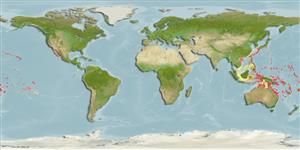Common names from other countries
Classification / Names
ชื่อสามัญ | ชื่อพ้อง | Catalog of Fishes(สกุล, ชนิด) | ITIS | CoL | WoRMS | Cloffa
>
Gobiiformes (Gobies) >
Xenisthmidae (Collared wrigglers)
Etymology: Xenisthmus: Greek, xenos = strange + Greek, isthmos = throat, narrow passage (Ref. 45335); eirospilus: Name from the Greek 'eiro' meaning to join in lines or string together, and 'spilos' for spot or fleck, refers to the prominent pattern of closely spaced dark spots on the mid-side; noun in apposition..
More on authors: Gill & Hoese.
Environment: milieu / climate zone / depth range / distribution range
นิเวศวิทยา
เกี่ยวกับทะเล,น้ำเค็ม สัตว์น้ำหน้าดิน; ระดับความลึก 0 - 35 m (Ref. 59014), usually 0 - 10 m (Ref. 90102). Tropical
Southwestern Pacific: Tasman Sea and the Solomons.
ขนาด / น้ำหนัก / Age
Maturity: Lm ? range ? - ? cm
Max length : 1.8 cm SL เพศผู้/กระเทย; (Ref. 59014); 2.1 cm SL (female)
Short description
เครื่องมือที่ใช้ในการแยกชนิดสัตว์,สิ่งมีชีวิตออกจากกัน | สัณฐานวิทยา | ความยาวต่างๆ
เงี่ยงครีบหลัง (รวม) : 7; ก้านครีบอ่อนที่หาง (รวม) : 12 - 13; เงี่ยงครีบก้น: 1; ก้านครีบอ่อนที่ก้น: 11 - 12; สัตว์มีกระดูกสันหลัง: 27. This species is characterized by the following: second dorsal-fin rays I, 12-13 (usually I, 12); A I, 11-12 (usually I, 11); vertebrae 10 + 17; indented tongue; posterior naris with well-developed flap on anterior rim; upper sides of the body with 12 large, closely spaced spots, these usually do not extend to dorsal edge of body; predorsal area broadly scaled to about vertical through posterior edge of preopercle (Ref. 59014).
A benthic, inshore species found in coral reefs (Ref. 75154). Also found in sand patches among reefs and rubble, often in surge areas (Ref 90102).
Life cycle and mating behavior
Maturities | การสืบพันธุ์ | Spawnings | Egg(s) | Fecundities | ตัวอ่อน
Gill, A.C. and D.F. Hoese, 2004. Three new Australian species of the fish genus Xenisthmus (Gobioidei: Xenisthmidae). Rec. Aust. Mus.56(2):241-246. (Ref. 59014)
IUCN Red List Status (Ref. 130435)
CITES (Ref. 128078)
Not Evaluated
Threat to humans
Harmless
Human uses
เครื่องมือ
Special reports
Download XML
แหล่งที่มาจากอินเตอร์เน็ต
Estimates based on models
Preferred temperature (Ref.
115969): 23.5 - 29.3, mean 28.2 (based on 1855 cells).
Phylogenetic diversity index (Ref.
82804): PD
50 = 0.5020 [Uniqueness, from 0.5 = low to 2.0 = high].
Bayesian length-weight: a=0.00389 (0.00180 - 0.00842), b=3.12 (2.94 - 3.30), in cm Total Length, based on all LWR estimates for this body shape (Ref.
93245).
ระดับชั้นอาหาร (Ref.
69278): 3.1 ±0.4 se; based on size and trophs of closest relatives
Fishing Vulnerability (Ref.
59153): Low vulnerability (10 of 100).
